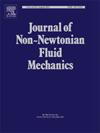Three-dimensional velocity fields measurement of bulge structure observed in a cavity via particle tracking velocimetry
IF 2.8
2区 工程技术
Q2 MECHANICS
引用次数: 0
Abstract
The viscoelastic flow of a surfactant solution in a continuous contraction-expansion flow channel exhibits three types of characteristic flows based on Reynolds numbers. At low Reynolds numbers, the Barus effect is observed in a cavity of the channel. At high Reynolds number, the separation flow, where the main flow separates from the fluids in the cavity, is observed, and the flow does not penetrate the cavity. At moderate Reynolds numbers, the fluid penetrates the cavity at the cavity midsection, changes the flow direction to the opposite direction of the main flow, returns to the forward direction near the upstream wall of the cavity, and flows out of the cavity. The flow regime is called the bulge structure. The bulge structure is an interesting flow regime observed in the cavity only when the surfactant solution exhibits high viscoelasticity. Three-dimensional velocity fields in the cavity were measured using particle tracking velocimetry (PTV) to elucidate the mechanism of the bulge structure appearance. From the three-dimensional velocity measurements, the unique velocity fields of the bulge structure were obtained. In particular, the spanwise velocity of the bulge structure was much higher at the cavity inlet and outlet than that at the Barus effect. This indicates that the expansion and contraction flow in the spanwise direction result in the bulge structure. A high spanwise flow was observed at the cavity inlet and outlet, which may have resulted from the expansion flow. Thus, the expansion flow, not only in the flow direction but also in the spanwise direction, generates the bulge structure in the cavity. In this study, the formation mechanism of the bulge structure was elucidated.
用粒子跟踪测速法测量腔体中凸起结构的三维速度场
表面活性剂溶液在连续收缩-膨胀流道中的粘弹性流动表现出三种基于雷诺数的特征流动。当雷诺数较低时,在通道的空腔中观察到巴鲁斯效应。在高雷诺数时,观察到主流与腔内流体分离的分离流,该流不穿透腔。中等雷诺数时,流体在空腔中段穿透空腔,改变流动方向与主流方向相反,在靠近空腔上游壁面处返回正向,流出空腔。这种流态称为凸起结构。膨胀结构是一种有趣的流动形式,只有当表面活性剂溶液表现出高粘弹性时,才会在空腔中观察到。利用粒子跟踪测速技术(PTV)对腔内三维速度场进行了测量,阐明了凸起结构的形成机理。通过三维速度测量,得到了凸起结构的独特速度场。特别是在空腔进出口处,凸起结构的展向速度比在巴鲁斯效应下高得多。这表明沿展向的膨胀和收缩流动导致了凸起结构的形成。在空腔入口和出口处观察到高的展向流动,这可能是膨胀流动的结果。因此,膨胀流动不仅在流动方向上,而且在展向上,在腔内产生凸起结构。本文探讨了隆起构造的形成机理。
本文章由计算机程序翻译,如有差异,请以英文原文为准。
求助全文
约1分钟内获得全文
求助全文
来源期刊
CiteScore
5.00
自引率
19.40%
发文量
109
审稿时长
61 days
期刊介绍:
The Journal of Non-Newtonian Fluid Mechanics publishes research on flowing soft matter systems. Submissions in all areas of flowing complex fluids are welcomed, including polymer melts and solutions, suspensions, colloids, surfactant solutions, biological fluids, gels, liquid crystals and granular materials. Flow problems relevant to microfluidics, lab-on-a-chip, nanofluidics, biological flows, geophysical flows, industrial processes and other applications are of interest.
Subjects considered suitable for the journal include the following (not necessarily in order of importance):
Theoretical, computational and experimental studies of naturally or technologically relevant flow problems where the non-Newtonian nature of the fluid is important in determining the character of the flow. We seek in particular studies that lend mechanistic insight into flow behavior in complex fluids or highlight flow phenomena unique to complex fluids. Examples include
Instabilities, unsteady and turbulent or chaotic flow characteristics in non-Newtonian fluids,
Multiphase flows involving complex fluids,
Problems involving transport phenomena such as heat and mass transfer and mixing, to the extent that the non-Newtonian flow behavior is central to the transport phenomena,
Novel flow situations that suggest the need for further theoretical study,
Practical situations of flow that are in need of systematic theoretical and experimental research. Such issues and developments commonly arise, for example, in the polymer processing, petroleum, pharmaceutical, biomedical and consumer product industries.

 求助内容:
求助内容: 应助结果提醒方式:
应助结果提醒方式:


